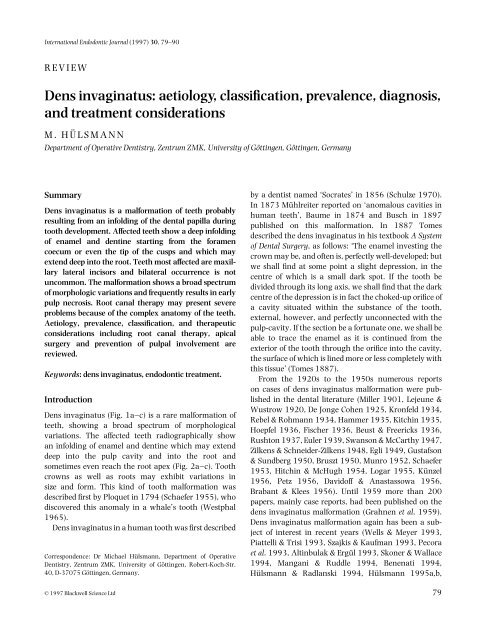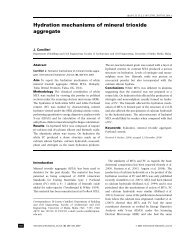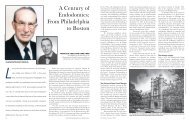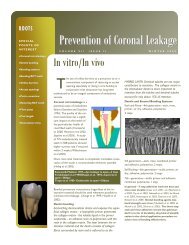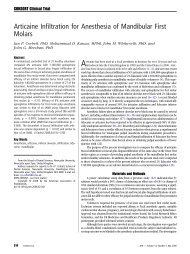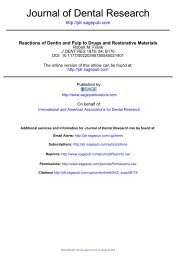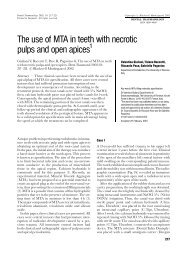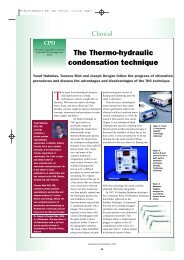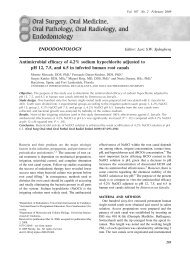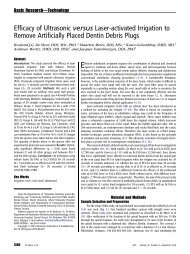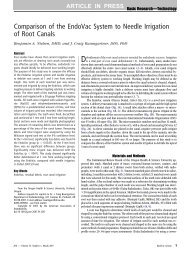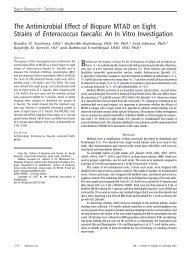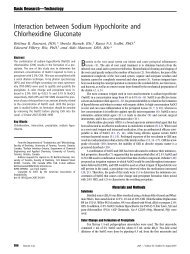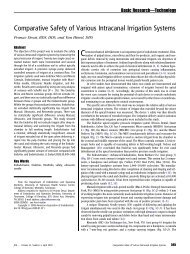Dens invaginatus - The EndoExperience
Dens invaginatus - The EndoExperience
Dens invaginatus - The EndoExperience
Create successful ePaper yourself
Turn your PDF publications into a flip-book with our unique Google optimized e-Paper software.
International Endodontic Journal (1997) 30, 79–90<br />
REVIEW<br />
<strong>Dens</strong> <strong>invaginatus</strong>: aetiology, classification, prevalence, diagnosis,<br />
and treatment considerations<br />
M. HÜLSMANN<br />
Department of Operative Dentistry, Zentrum ZMK, University of Göttingen, Göttingen, Germany<br />
Summary<br />
<strong>Dens</strong> <strong>invaginatus</strong> is a malformation of teeth probably<br />
resulting from an infolding of the dental papilla during<br />
tooth development. Affected teeth show a deep infolding<br />
of enamel and dentine starting from the foramen<br />
coecum or even the tip of the cusps and which may<br />
extend deep into the root. Teeth most affected are maxillary<br />
lateral incisors and bilateral occurrence is not<br />
uncommon. <strong>The</strong> malformation shows a broad spectrum<br />
of morphologic variations and frequently results in early<br />
pulp necrosis. Root canal therapy may present severe<br />
problems because of the complex anatomy of the teeth.<br />
Aetiology, prevalence, classification, and therapeutic<br />
considerations including root canal therapy, apical<br />
surgery and prevention of pulpal involvement are<br />
reviewed.<br />
Keywords: dens <strong>invaginatus</strong>, endodontic treatment.<br />
Introduction<br />
<strong>Dens</strong> <strong>invaginatus</strong> (Fig. 1a–c) is a rare malformation of<br />
teeth, showing a broad spectrum of morphological<br />
variations. <strong>The</strong> affected teeth radiographically show<br />
an infolding of enamel and dentine which may extend<br />
deep into the pulp cavity and into the root and<br />
sometimes even reach the root apex (Fig. 2a–c). Tooth<br />
crowns as well as roots may exhibit variations in<br />
size and form. This kind of tooth malformation was<br />
described first by Ploquet in 1794 (Schaefer 1955), who<br />
discovered this anomaly in a whale’s tooth (Westphal<br />
1965).<br />
<strong>Dens</strong> <strong>invaginatus</strong> in a human tooth was first described<br />
Correspondence: Dr Michael Hülsmann, Department of Operative<br />
Dentistry, Zentrum ZMK, University of Göttingen, Robert-Koch-Str.<br />
40, D-37075 Göttingen, Germany.<br />
by a dentist named ‘Socrates’ in 1856 (Schulze 1970).<br />
In 1873 Mühlreiter reported on ‘anomalous cavities in<br />
human teeth’, Baume in 1874 and Busch in 1897<br />
published on this malformation. In 1887 Tomes<br />
described the dens <strong>invaginatus</strong> in his textbook A System<br />
of Dental Surgery, as follows: ‘<strong>The</strong> enamel investing the<br />
crown may be, and often is, perfectly well-developed; but<br />
we shall find at some point a slight depression, in the<br />
centre of which is a small dark spot. If the tooth be<br />
divided through its long axis, we shall find that the dark<br />
centre of the depression is in fact the choked-up orifice of<br />
a cavity situated within the substance of the tooth,<br />
external, however, and perfectly unconnected with the<br />
pulp-cavity. If the section be a fortunate one, we shall be<br />
able to trace the enamel as it is continued from the<br />
exterior of the tooth through the orifice into the cavity,<br />
the surface of which is lined more or less completely with<br />
this tissue’ (Tomes 1887).<br />
From the 1920s to the 1950s numerous reports<br />
on cases of dens <strong>invaginatus</strong> malformation were published<br />
in the dental literature (Miller 1901, Lejeune &<br />
Wustrow 1920, De Jonge Cohen 1925, Kronfeld 1934,<br />
Rebel & Rohmann 1934, Hammer 1935, Kitchin 1935,<br />
Hoepfel 1936, Fischer 1936, Beust & Freericks 1936,<br />
Rushton 1937, Euler 1939, Swanson & McCarthy 1947,<br />
Zilkens & Schneider-Zilkens 1948, Egli 1949, Gustafson<br />
& Sundberg 1950, Bruszt 1950, Munro 1952, Schaefer<br />
1953, Hitchin & McHugh 1954, Logar 1955, Künzel<br />
1956, Petz 1956, Davidoff & Anastassowa 1956,<br />
Brabant & Klees 1956). Until 1959 more than 200<br />
papers, mainly case reports, had been published on the<br />
dens <strong>invaginatus</strong> malformation (Grahnen et al. 1959).<br />
<strong>Dens</strong> <strong>invaginatus</strong> malformation again has been a subject<br />
of interest in recent years (Wells & Meyer 1993,<br />
Piattelli & Trisi 1993, Szajkis & Kaufman 1993, Pecora<br />
et al. 1993, Altinbulak & Ergül 1993, Skoner & Wallace<br />
1994, Mangani & Ruddle 1994, Benenati 1994,<br />
Hülsmann & Radlanski 1994, Hülsmann 1995a,b,<br />
© 1997 Blackwell Science Ltd 79
80 M. Hülsmann<br />
Fig. 1 (a) SEM; (b) microscopic and (c) radiographic appearance of a dental invagination. <strong>The</strong> invagination is completely filled with debris.<br />
At the bottom of the invagination the enamel is missing.<br />
Ikeda et al. 1995, Oncag et al. 1995, Nagatani et al.<br />
1995, Khabbaz et al. 1995, Duckmanton 1995, Lindner<br />
et al. 1995, Bloch-Zupan et al. 1995, Olmez et al. 1995,<br />
Hosey & Bedi 1996).<br />
Synonyms for this malformation are: <strong>Dens</strong> in dente,<br />
invaginated odontome, dilated gestant odontome,<br />
dilated composite odontome, tooth inclusion, dentoid in<br />
dente.<br />
Fig. 2 (a) Invagination in the maxillary left lateral incisor. <strong>The</strong> invagination is limited to the tooth crown. <strong>The</strong> malformation was detected by<br />
chance. (b) Invagination in the maxillary left lateral incisor. <strong>The</strong> invagination is extending into the root. At the bottom of the invagination the<br />
enamel is missing. <strong>The</strong> invagination was suspected because of dysmorphic, peg-shaped tooth crown anatomy. (c) Severe case of dens <strong>invaginatus</strong><br />
with open apex, diverging root and bizarre form of the invagination with a separate apical opening. <strong>The</strong> malformation was detected because of<br />
retarded tooth eruption of tooth 12.<br />
© 1997 Blackwell Science Ltd, International Endodontic Journal, 30, 79–90
Aetiology of dens <strong>invaginatus</strong><br />
<strong>The</strong> aetiology of dens <strong>invaginatus</strong> malformation is<br />
controversial and remains unclear. Over the last decades<br />
several theories have been proposed to explain the<br />
aetiology of dental coronal invaginations:<br />
• Growth pressure of the dental arch results in buckling<br />
of the enamel organ (Euler 1939, Atkinson 1943).<br />
• Kronfeld (1934) suggested that the invagination<br />
results from a focal failure of growth of the internal<br />
enamel epithelium while the surrounding normal<br />
epithelium continues to proliferate and engulfs the<br />
static area.<br />
• Rushton (1937) proposed that the invagination is a<br />
result of rapid and aggressive proliferation of a part of<br />
the internal enamel epithelium invading the dental<br />
papilla. He regarded this a ‘benign neoplasma of<br />
limited growth’.<br />
• Oehlers (1957a,b) considered that distortion of the<br />
enamel organ during tooth development and subsequent<br />
protrusion of a part of the enamel organ will<br />
lead to the formation of an enamel-lined channel<br />
ending at the cingulum or occasionally at the incisal<br />
tip. <strong>The</strong> latter might be associated with irregular<br />
crown form.<br />
• <strong>The</strong> ‘twin-theorie’ (Bruszt 1950) suggested a fusion of<br />
two tooth-germs.<br />
• Infection was considered to be responsible for the<br />
malformation by Fischer (1936) and Sprawson<br />
(1937).<br />
• Gustafson & Sundberg (1950) discussed trauma as a<br />
causative factor, but could not sufficiently explain<br />
why just maxillary lateral incisors were affected and<br />
not central incisors.<br />
Most authors, meanwhile, consider dens <strong>invaginatus</strong> as<br />
a deep folding of the foramen coecum during tooth<br />
development which in some cases even may result in a<br />
second apical foramen (Schulze 1970). On the other<br />
hand the invagination also may start from the incisal<br />
edge of the tooth. Genetic factors cannot be excluded<br />
(Grahnen 1962, Casamassimo et al. 1978, Ireland et al.<br />
1987, Hosey & Bedi 1996).<br />
Classification of dens <strong>invaginatus</strong><br />
<strong>The</strong> first classification of invaginated teeth was published<br />
by Hallet (1953). <strong>The</strong> most commonly used<br />
classification proposed by Oehlers (1957a) is shown in<br />
Fig. 3. He described the anomaly occurring in three<br />
forms:<br />
Type I: an enamel-lined minor form occurring within<br />
© 1997 Blackwell Science Ltd, International Endodontic Journal, 30, 79–90<br />
the confines of the crown not extending<br />
beyond the amelocemental junction.<br />
Type II: an enamel-lined form which invades the root<br />
but remains confined as a blind sac. It may or<br />
may not communicate with the dental pulp.<br />
Type III: a form which penetrates through the root perforating<br />
at the apical area showing a ‘second<br />
foramen’ in the apical or in the periodontal<br />
area. <strong>The</strong>re is no immediate communication<br />
with the pulp. <strong>The</strong> invagination may be completely<br />
lined by enamel, but frequently cementum<br />
will be found lining the invagination.<br />
Oehlers (1957a,b) also described different crown forms<br />
(normal with a deep lingual or palatal pit; conical,<br />
barrel-shaped or peg-shaped with an incisal pit) relating<br />
to the three groups mentioned above. In addition,<br />
Ulmansky & Hermel (1964) and Vincent-Townend<br />
(1974) described an ‘incipient dens in dente’, a deep<br />
palatal or lingual pit completely lined by enamel with no<br />
communication to the pulp. Oehlers (1958) also<br />
presented radicular invaginations.<br />
Schulze & Brand (1972) proposed a more detailed<br />
classification (Fig. 4), also including invaginations<br />
starting at the incisal edge or the top of the crown and<br />
also including dysmorphic root configurations.<br />
Prevalence of dens <strong>invaginatus</strong><br />
<strong>Dens</strong> <strong>invaginatus</strong> 81<br />
Fig. 3 Classification of invaginated teeth by Oehlers (1957).<br />
A summary of the results of investigations on the prevalence<br />
of invaginated teeth is presented in Table 1. It is<br />
difficult to compare findings because of the differences<br />
in study design, sample size and composition, and<br />
diagnostic criteria. <strong>The</strong> teeth most affected are maxillary<br />
lateral incisors and bilateral occurrence is not uncommon<br />
and occurs in 43% of all cases (Grahnen et al. 1959).
82 M. Hülsmann<br />
Fig. 4 Classification of dens <strong>invaginatus</strong> by Schulze & Brand (1972)<br />
(from: Zahnärztliche Welt/Reform 81, 569–73, with kind permission).<br />
Swanson & McCarthy (1947) were the first to present<br />
bilateral dens <strong>invaginatus</strong> malformation, Conklin<br />
(1968) presented a patient with all maxillary central<br />
and lateral incisors affected, and Burton et al. (1980)<br />
Table 1 Investigations on the prevalence of dens <strong>invaginatus</strong><br />
published a case with six teeth involved, the maxillary<br />
incisors and also the maxillary canines. Krolls (1969)<br />
detected dental invaginations in maxillary central<br />
incisors as well as in several maxillary and mandibular<br />
bicuspids in one patient. Conklin (1978) found the<br />
anomaly in four mandibular incisors in one patient.<br />
Double invaginations in one tooth were reported by<br />
Rushton (1937), Archer & Silverman (1950), Oehlers<br />
(1957a), Grahnen et al. (1959), Ulmansky & Hermel<br />
(1964), Schulze & Brand (1972), Brill & Phillips (1974),<br />
Bhatt & Dholakia (1975), Conklin (1975), Cole et al.<br />
(1978), Gotoh et al. (1979), Mader (1979), Rotstein<br />
et al. (1987a), and Vairabhaya (1989). Triple invaginations<br />
were described by Hitchin & McHugh (1954) and<br />
Mader (1977). In rare cases even primary teeth seem to<br />
be affected (Rabinowitch 1952).<br />
Cases of dental invaginations in supernumerary teeth<br />
have been presented as well as in canines and bicuspids<br />
(Archer & Silverman 1950, Schwenzer 1957, Kruse<br />
1962, Klammt 1969, Conklin 1975, Banner 1978,<br />
Author/Country Year Sample Frequency<br />
Mühlreiter 1873 500 extracted lateral maxillary 2.8% of teeth<br />
(Austria) incisors (histological investigation)<br />
Atkinson 1943 500 lateral maxillary incisors 10% of teeth<br />
(USA)<br />
Boyne 1952 1000 maxillary incisors 0.3% of teeth<br />
(USA)<br />
Stephens 1953 150 full-mouth surveys 8%<br />
(unknown) 1953 1000 patients 3.6% (cited by Hovland & Block 1977)<br />
Shafer 1953 2542 full-mouth surveys 1.3% of patients<br />
(USA) (cited by Hovland & Block 1977)<br />
Hallet 1953 586 full-mouth surveys 6.6% of maxillary lateral incisors<br />
(unknown) 0.5% of maxillary central incisors<br />
(cited by Hovland & Block 1977)<br />
Amos 1955 1000 full mouth surveys 5.1% of patients<br />
(USA) 203 full mouth surveys 6.9% (students of dentistry)<br />
Grahnen et al. 1959 3020 right maxillary incisors 2.7% of patients<br />
(Sweden)<br />
Ulmansky & 1964 500 full mouth surveys 2% of patients<br />
Hermel (Israel)<br />
Poyton & Morgan 1966 5000 full mouth surveys 0.25% of patients<br />
(Canada) (cited by Hovland & Block 1977)<br />
Miyoshi et al. 1971 extracted maxillary lateral 38.5% of teeth<br />
( Japan) incisors (cited by Gotoh et al. 1979)<br />
Fujiki et al. 1974 2126 lateral maxillary incisors 4.2% of teeth<br />
( Japan) (cited by Gotoh et al. 1979)<br />
Thomas 1974 1886 full mouth surveys 7.74% of patients<br />
(USA)<br />
Gotoh et al. 1979 766 lateral maxillary incisors 9.66% of teeth<br />
( Japan)<br />
Ruprecht et al. 1986 1581 full mouth surveys 1.7% of patients<br />
(Saudi Arabia)<br />
Ruprecht et al. 1987 300 full mouth surveys 10% of patients<br />
(Saudi Arabia)<br />
© 1997 Blackwell Science Ltd, International Endodontic Journal, 30, 79–90
Shifman & Tamir 1979, Bottomley & Johnson 1982,<br />
Eldeeb 1984, Rotstein et al. 1987a, Morfis 1992,<br />
Bramante et al. 1993, Altinbulak & Ergül 1993,<br />
Hülsmann & Radlanski 1994, Tavano et al. 1994).<br />
Histological findings<br />
Several reports on microscopic, ultrastructural and<br />
microradiographic investigations of teeth with a dens<br />
<strong>invaginatus</strong> malformation show a wide range of findings<br />
and thus reproduce the macroscopic variety of this<br />
anomaly. <strong>The</strong> dentine below the invagination may be<br />
intact without irregularities (Brabant & Klees 1956,<br />
Omnell et al. 1960, Piatelli & Trisi 1993) but also may<br />
contain strains of vital connective tissue (Omnell et al.<br />
1960) or even fine canals with communication to the<br />
dental pulp (Kronfeld 1934, Fischer 1936, Hoepfel<br />
1936, Gustafson & Sundberg 1950, Hitchin & McHugh<br />
1954, Oehlers 1957a, Rushton 1958). Some authors<br />
reported hypomineralized or irregularly structured<br />
dentine (Omnell et al. 1960, Vincent-Townend 1974,<br />
Beynon 1982). <strong>The</strong> structure and thickness of the<br />
enamel lining the invagination also may vary widely.<br />
<strong>The</strong> enamel was described as irregularly structured by<br />
Atkinson (1943), Beynon (1982) and Piatelli & Trisi<br />
(1993). Beynon (1982) reported hypomineralized<br />
enamel at the base of the invagination whereas Morfis<br />
(1992), in a chemical analysis, detected up to eight<br />
times more phosphate and calcium compared with the<br />
outer enamel, but in his analysis magnesium was<br />
missing completely. Bloch-Zupan et al. (1995) found<br />
differences in structure and compostion between the<br />
external and internal enamel. <strong>The</strong> internal enamel<br />
exhibited atypical and more complex rod shapes and its<br />
surface presented the typical honeycomb pattern but no<br />
perikymata, which, however, were observed on the<br />
outer surface of the tooth.<br />
Diagnosis of dens <strong>invaginatus</strong><br />
In most cases a dens <strong>invaginatus</strong> is detected by chance<br />
on the radiograph. Clinically, an unusual crown morphology<br />
(‘dilated’, ‘peg-shaped’, ‘barrel-shaped’) or a<br />
deep foramen coecum may be important hints, but<br />
affected teeth also may show no clinical signs of the<br />
malformation. As maxillary lateral incisors are the teeth<br />
most susceptible to coronal invaginations these teeth<br />
should be investigated thoroughly clinically and radiographically,<br />
at least in all cases with a deep pit at the<br />
foramen coecum. If one tooth is affected in a patient the<br />
contralateral tooth should also be investigated. As<br />
© 1997 Blackwell Science Ltd, International Endodontic Journal, 30, 79–90<br />
pulpal involvement of teeth with coronal invaginations<br />
may occur a short time after tooth eruption early diagnosis<br />
is mandatory to instigate preventive treatment.<br />
Clinical features<br />
<strong>The</strong> invagination allows entry of irritants into an area<br />
which is separated from pulpal tissue by only a thin layer<br />
of enamel and dentine and presents a predisposition for<br />
the development of dental caries. In some cases the<br />
enamel-lining is incomplete (Fig. 1). Channels may also<br />
exist between the invagination and the pulp (Kronfeld<br />
1934, Hitchin & McHugh 1954). <strong>The</strong>refore, pulp<br />
necrosis often occurs rather early, within a few years of<br />
eruption, sometimes even before root end closure<br />
(Swanson & McCarthy 1947, Ulmansky & Hermel 1964,<br />
Stepanik 1968, Ferguson et al. 1980, Morfis & Lentzari<br />
1989, Nik-Hussein 1994, Hülsmann & Radlanski 1994)<br />
(Fig. 5a, b). Other reported sequelae of undiagnosed and<br />
untreated coronal invaginations are abscess formation<br />
(Schaefer 1955, Petz 1956, Kendrick 1971, Greenfield<br />
& Cambruzzi 1986, Chen et al. 1990, Whyman &<br />
McFayden 1994), retention of neighbouring teeth<br />
(Schaefer 1955, Petz 1956, Conklin 1975, Mader<br />
1977), displacement of teeth (Schaefer 1955, Petz<br />
1956), cysts (Rebel & Rohmann 1934, Schwenzer<br />
1957, Conklin 1978, Klammt 1969, Burzynski 1973,<br />
Samimy 1977, Murphy & Doku 1977, Augsburger &<br />
Brandebura 1978, Greenfield & Cambruzzi 1986), and<br />
internal resorption (Shapiro 1970, Hülsmann &<br />
Radlanski 1994) (Fig. 6).<br />
<strong>The</strong> dental literature on dens <strong>invaginatus</strong> malformations<br />
contains several case reports presenting invaginated<br />
teeth coincident with other dental anomalies,<br />
malformations and even dental or medical syndromes<br />
(Table 2).<br />
Treatment considerations<br />
Preventive and restorative treatment<br />
<strong>Dens</strong> <strong>invaginatus</strong> 83<br />
Teeth with deep palatal or incisal invaginations or<br />
foramina coeca should be treated with fissure sealing<br />
before carious destruction can occur. A composite<br />
restoration and strict periodic review is recommended<br />
(Rotstein et al. 1987b, Hülsmann & Radlanski 1994). If<br />
no entrance to the invagination can be detected and no<br />
signs of pathosis are visible clinically and radiographically<br />
no treatment is indicated, but strict observation is<br />
recommended (Hülsmann 1995b, Duckmanton 1995,<br />
Hülsmann 1996).
84 M. Hülsmann<br />
Fig. 5 (a) Small coronal invagination in tooth 22. (b) Three years later arrest of root development and pulp necrosis, with apical periodontitis, and<br />
sinus tract have appeared. (c) Fifteen months later: following apexification therapy with calcium hydroxide and obturation of the root canal the<br />
periapical status has improved.<br />
Root canal treatment<br />
A review of the literature shows that extraction of teeth<br />
with invaginations was the preferred therapy until the<br />
1970s (Hülsmann 1995a). Grossman (1974) and<br />
Creaven (1975) were the first to describe root canal<br />
Table 2 Dental anomalies described in association with dens <strong>invaginatus</strong><br />
Microdontia Casamassimo et al. 1978<br />
Macrodontia Ekman-Westberg & Julin 1974<br />
Hypodontia Hülsmann 1995c<br />
Oligodontia Conklin 1978, Ruprecht et al. 1986<br />
Taurodontism Casamassimo et al. 1978,<br />
Ruprecht et al.1986,<br />
Ireland et al. 1987,<br />
Chen et al. 1990<br />
Gemination and Fusion Burzynski 1973, Mader 1979,<br />
Mader & Zielke 1982,<br />
Ruprecht et al. 1986<br />
Supernumerary teeth Schaefer 1953, 1955,<br />
Brabant & Klees 1956,<br />
Petz 1956, Rushton 1958,<br />
Conklin 1975, Mader<br />
1977, Shifman & Tamir 1979,<br />
Beynon 1982, Ruprecht et al. 1986,<br />
Morfis 1992<br />
Amelogenesis imperfecta Kerebel et al. 1983<br />
Invagination in an odontome Hitchin & McHugh 1954<br />
Multiple odontomes Robbins & Keene 1964<br />
Coronal agenesis Hicks & Flaitz 1985<br />
Williams syndrome Oncag et al. 1995<br />
treatment of the invagination only (root invagination<br />
treatment) and Tagger (1977) and Hovland & Block<br />
(1977) the first to present cases treated with conventional<br />
root canal therapy (Fig. 7a,b). Root canal treatment<br />
may present several problems because of the<br />
irregular shape of the root canal system(s). If there<br />
are no radiographic signs of pulp pathosis and no<br />
communication between the invagination and the<br />
root canal, root canal treatment or, in minor cases, even<br />
a composite or amalgam filling of the invagination will<br />
be adequate (DeSmit & Demaut 1982). When the invagination<br />
has a separate apical or lateral foramen, root<br />
canal treatment of the invagination is indicated<br />
(Grossman 1974, Creaven 1975, Bolanos et al. 1988,<br />
Szajkis & Kaufman 1993, Wells & Meyer 1993, Ikeda<br />
et al. 1995). In some cases it may be possible to bur<br />
through the invagination to get access to the apical<br />
foramen. When these minor forms of invaginations<br />
are eliminated root canal therapy in most cases will<br />
not present further problems. In certain cases the invagination<br />
has to be treated as a separate root canal (Cole<br />
et al. 1978, Zillich et al. 1983, Eldeeb 1984, Greenfield<br />
& Cambruzzi 1986, Mangani & Ruddle 1994, Khabbaz<br />
et al. 1995).<br />
When pulp necrosis occurs before root-end closure,<br />
apexification procedures with calcium hydroxide may be<br />
necessary (Ferguson et al. 1980, Morfis & Lentzari 1989,<br />
Vairabhaya 1989, Hülsmann & Radlanski 1994,<br />
Nagatani et al. 1995) (Fig. 5a–c).<br />
© 1997 Blackwell Science Ltd, International Endodontic Journal, 30, 79–90
<strong>The</strong> large and irregular volume of the root canal<br />
system makes proper shaping and cleaning difficult.<br />
Irrigation, supported by ultrasonic cleaning of the root<br />
canal system has been described as an efficient means of<br />
disinfection (Cunningham et al. 1982) and has therefore<br />
been recommended for cleaning of the complex<br />
morphology of the root canal system in teeth with dens<br />
<strong>invaginatus</strong> (Skoner & Wallace 1994). For obturation of<br />
such teeth warm gutta-percha techniques including<br />
vertical condensation or thermoplastic filling techniques<br />
have been recommended (Rotstein et al. 1987b,<br />
Hülsmann & Radlanski 1994, Mangani & Ruddle<br />
1994).<br />
© 1997 Blackwell Science Ltd, International Endodontic Journal, 30, 79–90<br />
Surgical treatment<br />
<strong>Dens</strong> <strong>invaginatus</strong> 85<br />
Fig. 6 (a) Pulp necrosis, apical periodontitis, sinus tract, and<br />
lateral resorptive perforation in tooth 12 showing a dens <strong>invaginatus</strong><br />
malformation. (b) Clinical view of the tooth crown of the<br />
same tooth before treatment. A deep foramen coecum with caries<br />
is visible. (c) After preparation of the access cavity the entrance to<br />
the invagination is visible at the palatal aspect (arrow). <strong>The</strong> main<br />
root canal orifice can be seen at the top of the cavity at the buccal<br />
aspect.<br />
Surgical treatment should be considered in cases of<br />
endodontic failure and in teeth which cannot be treated<br />
non-surgically because of anatomical problems or<br />
failure to gain access to all parts of the root canal system<br />
(Harnisch 1970, Hata & Toda 1987, Teplitsky & Singer<br />
1987, Rotstein et al. 1987b, Kulild & Weller 1989,<br />
Suchina et al. 1989, Hülsmann & Radlanski 1994,<br />
Benenati 1994, Olmez et al. 1995) (Fig. 8a,b). Cole et al.<br />
(1978) and Lindner et al. (1995) even proposed intentional<br />
replantation with retrograde surgery in otherwise<br />
hopeless cases.
86 M. Hülsmann<br />
Fig. 7 (a) Right maxillary lateral incisor in the same patient as in Fig. 5. <strong>The</strong> invagination was detected<br />
by preventive radiographic examination, clinically no invagination nor carious lesion were detected.<br />
<strong>The</strong> invagination has resulted in an internal resorption with perforation. (b) Obturation with injectable<br />
gutta-percha, resulting in a slight lateral overfill.<br />
Fig. 8 (a) Radiograph of tooth 23 showing a bizarre lateral coronal invagination which seems to be open<br />
to the lateral periodontium. <strong>The</strong> main root canal was root canal treated, but no communication to the<br />
invagination could be detected. (b) As no access to the invagination was found coronally the invagination<br />
was treated surgically. Probably root canal treatment of the main root canal would not have been<br />
necessary.<br />
© 1997 Blackwell Science Ltd, International Endodontic Journal, 30, 79–90
Fig. 9 (a) Severe dens <strong>invaginatus</strong> malformation with acute apical abscess formation. <strong>The</strong> tooth was<br />
judged inoperable and extracted by a general dental practitioner. (b) <strong>The</strong> photograph of the extracted<br />
tooth shows the invagination extending beyond the apex.<br />
Fig. 10 Severe invagination malformation of tooth 22 resulting in<br />
acute apical abscess formation. <strong>The</strong> tooth was judged inoperable and<br />
extracted.<br />
© 1997 Blackwell Science Ltd, International Endodontic Journal, 30, 79–90<br />
Extraction<br />
Extraction is indicated only in teeth with severe anatomical<br />
irregularities that cannot be treated non-surgically<br />
or by apical surgery, and in supernumerary teeth<br />
(Figs 9a,b and 10). Additionally Rotstein et al. (1987b)<br />
advocated extraction when abnormal crown morphology<br />
presents aesthetic or functional problems.<br />
References<br />
<strong>Dens</strong> <strong>invaginatus</strong> 87<br />
ALTINBULAK H, ERGÜL N (1993) Multiple dens <strong>invaginatus</strong>. Oral<br />
Surgery, Oral Medicine and Oral Pathology 76, 620–2.<br />
AMOS ER (1955) Incidence of the small dens in dente. Journal of the<br />
American Dental Association 51, 31–3.<br />
ARCHER WH, SILVERMAN LM (1950) Double dens in dente in bilateral<br />
rudimentary supernumerary central incisors. Oral Surgery, Oral<br />
Medicine and Oral Pathology 3, 722.<br />
ATKINSON SR (1943) <strong>The</strong> permanent maxillary lateral incisor.<br />
American Journal of Orthodontics 29, 685–98.<br />
AUGSBURGER RA, BRANDEBURA J (1978) Bilateral dens <strong>invaginatus</strong><br />
with associated radicular cysts. Oral Surgery, Oral Medicine and Oral<br />
Pathology 46, 260–4.<br />
BANNER H (1978) Bilateral dens in dente in mandibular premolars.<br />
Oral Surgery, Oral Medicine and Oral Pathology 45, 827–8.<br />
BAUME R (1874) Zahnmibildungen. I. Ein Zahn im Zahne. Deutsche<br />
Vierteljahresschrift für Zahnheilkunde 14, 25–9.<br />
BENENATI FW (1994) Complex treatment of a maxillary lateral incisor<br />
with dens <strong>invaginatus</strong> and associated aberrant morphology. Journal<br />
of Endodontics 20, 180–2.
88 M. Hülsmann<br />
BEUST TB, FREERICKS FH (1936) <strong>Dens</strong> in dente. Journal of Dental<br />
Research 15, 158.<br />
BEYNON AD (1982) Developing dens <strong>invaginatus</strong> (dens in dente). A<br />
quantitative microradiographic study and a reconsideration of the<br />
histogenesis of this condition. British Dental Journal 153, 255–60.<br />
BHATT AP, DHOLAKIA HM (1975) Radicular variety of double dens in<br />
dente. Oral Surgery, Oral Medicine and Oral Pathology 39, 284–7.<br />
BLOCH-ZUPAN A, COUSANDIER L, HEMMERLE J, OBRY-MUSSET AM,<br />
MANIERE MC (1995) Electron microscopical assessments (FDIabstract<br />
FC-11# 123). International Dental Journal 45, 306.<br />
BOLANOS OR, MARTELL B, MORSE DR (1988) A unique approach to the<br />
treatment of a tooth with dens <strong>invaginatus</strong>. Journal of Endodontics<br />
14, 315–7.<br />
BOTTOMLEY WK, JOHNSON MR (1982) Multiple dens in dente in a<br />
dentition. Oral Surgery, Oral Medicine and Oral Pathology 54, 478.<br />
BOYNE PJ (1952) <strong>Dens</strong> in dente: Report of three cases. Journal of the<br />
Americal Dental Association 45, 209–10.<br />
BRABANT H, KLEES L (1956) Beitrag zur Kenntnis der ‘dens in dente’<br />
benannten Zahnanomalie. Stoma 9, 12–27.<br />
BRAMANTE CM, DESOUSA SM, TAVANOSM (1993) <strong>Dens</strong> <strong>invaginatus</strong> in<br />
mandibular first premolar. Oral Surgery, Oral Medicine and Oral<br />
Pathology 76, 389.<br />
BRILL WA, PHILLIPS JE (1974) Double <strong>Dens</strong> <strong>invaginatus</strong>. Oral Surgery,<br />
Oral Medicine and Oral Pathology 37, 139–40.<br />
BRUSZT P (1950) Über die Entstehung des ‘<strong>Dens</strong> in dente’. Schweizer<br />
Monatsschrift für Zahnheilkunde 60, 534–42.<br />
BURTON DJ, SAFFOS RO, SCHEFFER RB (1980) Multiple bilateral dens in<br />
dente as a factor in the etiology of multiple periapical lesions. Oral<br />
Surgery, Oral Medicine and Oral Pathology 49, 496–99.<br />
BURZYNSKINJ (1973) Gemination and dens in dente. Oral Surgery, Oral<br />
Medicine and Oral Pathology 36, 760–1.<br />
BUSCH N (1897) Über Verschmelzung und Verwachsung der Zähne<br />
des Milchgebisses und des bleibenden Gebisses. Deutsche<br />
Monatsschrift für Zahnheilkunde 15, 469–86.<br />
CASAMASSIMO PS, NOWAK AJ, ETTINGER RL, SCHLENKER DJ (1978) An<br />
unusual triad: microdontia, taurodontia, and dens <strong>invaginatus</strong>. Oral<br />
Surgery, Oral Medicine and Oral Pathology 45, 107–12.<br />
CHEN RJ, YANG JF, CHAO TC (1990) Invaginated tooth associated with<br />
periodontal abscess. Oral Surgery, Oral Medicine and Oral Pathology<br />
69, 659.<br />
COLE GM, TAINTOR JF, JAMES GA (1978) Endodontic therapy of a<br />
dilated dens <strong>invaginatus</strong>. Journal of Endodontics 4, 88–90.<br />
CONKLIN WW (1968) Multiple dens in dente. Oral Surgery, Oral<br />
Medicine and Oral Pathology 25, 193.<br />
CONKLIN WW (1975) Double bilateral dens <strong>invaginatus</strong> in the maxillary<br />
incisor region. Oral Surgery, Oral Medicine and Oral Pathology 39,<br />
949–52.<br />
CONKLIN WW (1978) Bilateral dens <strong>invaginatus</strong> in the mandibular<br />
incisor region. Oral Surgery, Oral Medicine and Oral Pathology 45,<br />
905–8.<br />
CREAVEN J (1975) <strong>Dens</strong> <strong>invaginatus</strong>-type malformation without<br />
pulpal involvement. Journal of Endodontics 1, 79–80.<br />
CUNNINGHAM W, MARTIN H, PELLEU G, STOOPS D (1982) A comparison<br />
of antimicrobial effectiveness of endosonic and hand root canal<br />
therapy. Oral Surgery, Oral Medicine and Oral Pathology 54, 238–41.<br />
DAVIDOFF SM, ANASTASSOWA MN (1956) Dentoid in dente. Deutsche<br />
Zahn-, Mund- und Kieferheilkunde 23, 454–68.<br />
DE JONGE COHEN TE (1925) Ein neuer Beitrag zur Morphogenese des<br />
‘dens in dente’. Vierteljahrschrift für Zahnheilkunde 41, 125–30.<br />
DE SMIT A, DEMAUT L (1982) Nonsurgical endodontic treatment of<br />
invaginated teeth. Journal of Endodontics 8, 506–11.<br />
EGLI AR (1949) Beitrag zur Frage des ‘<strong>Dens</strong> in dente’. Deutsche<br />
Zahnärztliche Zeitschrift 4, 432–7.<br />
DUCKMANTON PM (1995) Maxillary permanent central incisor with<br />
abnormal crown size and dens <strong>invaginatus</strong>: case report. Endodontics<br />
and Dental Traumatology 11, 150–2.<br />
EKMAN-WESTBORG B, JULIN P (1974) Multiple anomalies in dental<br />
morphology: macrodontia, multituberculism, central cusps, and<br />
pulp invaginations. Oral Surgery, Oral Medicine and Oral Pathology<br />
38, 217–22.<br />
ELDEEB ME (1984) Nonsurgical endodontic therapy of a dens <strong>invaginatus</strong>.<br />
Journal of Endodontics 10, 107–9.<br />
EULER H (1939) Die Anomalien, Fehlbildungen und Verstümmelungen der<br />
menschlichen Zähne. pp. 62–7, München, Germany: Lehmann.<br />
FERGUSON FS, FRIEDMAN S, FRAZZETTO V (1980) Successful<br />
apexification technique in an immature tooth with dens in dente.<br />
Oral Surgery, Oral Medicine and Oral Pathology 49, 356–59.<br />
FISCHERCH (1936) Zur Frage des <strong>Dens</strong> in dente. Deutsche Zahn-, Mundund<br />
Kieferheilkunde 3, 621–34.<br />
FUJIKI Y, TAMAKI N, KAWAHARA K, NABAE M (1974) Clinical and<br />
radiographic observations of dens <strong>invaginatus</strong>. Journal of<br />
Dentomaxillofacial Radiology 3, 343–8.<br />
GOTOH T, KAWAHARA K, IMAI K, KISHI K, FUJIKI Y (1979) Clinical and<br />
radiographic study of dens <strong>invaginatus</strong>. Oral Surgery, Oral Medicine<br />
and Oral Pathology 48, 88–91.<br />
GRAHNEN H, LINDAHL B, OMNELL K (1959) <strong>Dens</strong> <strong>invaginatus</strong>. I. A<br />
clinical, roentgenological and genetical study of permanent upper<br />
lateral incisors. Odontologisk Revy 10, 115–37.<br />
GRAHNEN H (1962) Hereditary factors in relation to dental caries and<br />
congenitally missing teeth. In: Witkop CJ, ed. Genetics and Disorder.<br />
pp. 194–204, New York, USA: McGraw-Hill.<br />
GREENFELD RS, CAMBRUZZI JV (1986) Complexities of endodontic<br />
treatment of maxillary lateral incisors with anomalous root formation.<br />
Oral Surgery, Oral Medicine and Oral Pathology 62, 82–8.<br />
GROSSMAN LI (1974) Endodontic case reports. Dental Clinics of North<br />
America 18, 509–28.<br />
GUSTAFSON G, SUNDBERGS (1950) <strong>Dens</strong> in dente. British Dental Journal<br />
88, 83–88, 111–122, 144–146.<br />
HALLET GE (1953) <strong>The</strong> incidence, nature and clinical significance of<br />
palatal invagination in the maxillary incisors teeth. Proceedings of<br />
the Royal Society of Medicine 46, 491–9.<br />
HAMMER H (1935) Zwei Fälle eigenartiger Zahnmibildung. Deutsche<br />
Zahn-, Mund- und Kieferheilkunde 2, 46–52.<br />
HARNISCH H (1970) Apicectomy in dens in dente. Quintessence<br />
International 1, 21–2.<br />
HATA G, TODA T (1987) Treatment of dens <strong>invaginatus</strong> by endodontic<br />
therapy, apicocurettage, and retrofilling. Journal of Endodontics 9,<br />
469–72.<br />
HICKS MJ, FLAITZ CM (1985) <strong>Dens</strong> <strong>invaginatus</strong> with partial<br />
coronal agenesis: report of a case. Journal of Dentistry for Children 52,<br />
217–9.<br />
HITCHIN AD, MCHUGH WD (1954) Three coronal invaginations in a<br />
dilated composite odontome. British Dental Journal 97, 90–2.<br />
HOEPFEL W (1936) Der <strong>Dens</strong> in dente. Deutsche Zahn-, Mund- und<br />
Kieferheilkunde 3, 67–80.<br />
HOSEY MT, BEDI R (1996) Multiple dens <strong>invaginatus</strong> in two brothers.<br />
Endodontics and Dental Traumatology 12, 44–7.<br />
HOVLAND EJ, BLOCK RM (1977) Nonrecognition and subsequent<br />
endodontic treatment of dens <strong>invaginatus</strong>. Journal of Endodontics 3,<br />
360–2.<br />
HÜLSMANN M (1995a) Der <strong>Dens</strong> <strong>invaginatus</strong> — Ätiologie, Inzidenz<br />
und klinische Besonderheiten. Schweizer Monatsschrift für<br />
Zahnmedizin 105, 765–76.<br />
HÜLSMANN M (1995b) <strong>The</strong>rapie des <strong>Dens</strong> <strong>invaginatus</strong>. Schweizer<br />
Monatsschrift für Zahnmedizin 105, 1323–34.<br />
HÜLSMANN M (1995c) <strong>Dens</strong> <strong>invaginatus</strong>: incidence, aetiology,<br />
© 1997 Blackwell Science Ltd, International Endodontic Journal, 30, 79–90
diagnosis, and treatment options. Poster-presentation, 6th ESE-<br />
Congress, Tel Aviv, 1995.<br />
HÜLSMANN M (1996) Severe dens <strong>invaginatus</strong> malformation. Report<br />
of two cases. Oral Surgery, Oral Medicine and Oral Pathology 82, 456–8.<br />
HÜLSMANN M, RADLANSKI R (1994) Möglichkeiten der konservativen<br />
<strong>The</strong>rapie des <strong>Dens</strong> <strong>invaginatus</strong>. Deutsche Zahnärztliche Zeitschrift 49,<br />
804–8.<br />
IKEDA H, YOSHIOKA T, SUDA H (1995) Importance of clinical examination<br />
and diagnosis. Oral Surgery, Oral Medicine and Oral Pathology 79,<br />
88–91.<br />
IRELAND JE, BLACK JP, SCURES CC (1987) Short roots, taurodontia and<br />
multiple dens <strong>invaginatus</strong>. Journal of Pedodontics 11, 164–75.<br />
KENDRICK JK (1971) Periapical abscess from dens in dente. Oral<br />
Surgery, Oral Medicine and Oral Pathology 31, 838.<br />
KEREBEL B, KEREBEL LM, DACULSI G, DOURY J (1983) Dentinogenesis<br />
imperfecta with dens in dente. Oral Surgery, Oral Medicine and Oral<br />
Pathology 55, 279–85.<br />
KHABBAZ MG, KONSTANTAKI MN, SYKARAS SN (1995) <strong>Dens</strong> <strong>invaginatus</strong><br />
in a mandibular lateral incisor. International Endodontic<br />
Journal 28, 303–5.<br />
KITCHIN PC (1935) <strong>Dens</strong> in dente. Journal of Dental Research 15,<br />
117–21.<br />
KLAMMT J (1969) <strong>Dens</strong> <strong>invaginatus</strong> und Zyste. Deutsche Zahn-, Mundund<br />
Kieferheilkunde 53, 336–47.<br />
KROLLS SO (1969) A dentition with multiple dens in dente. Oral<br />
Surgery, Oral Medicine and Oral Pathology 27, 648.<br />
KRONFELD R (1934) <strong>Dens</strong> in dente. Journal of Dental Research 14,<br />
49–66.<br />
KRUSE H (1962) <strong>Dens</strong> in dente im Prämolarenbereich des Unterkiefers.<br />
Deutsche Zahnärztliche Zeitschrift 17, 1532–5.<br />
KÜNZEL W (1956) Bilaterales Vorkommen des <strong>Dens</strong> in dente.<br />
Zahnärztliche Praxis 7, 1–2.<br />
KULILD JC, WELLER N (1989) Treatment considerations in dens <strong>invaginatus</strong>.<br />
Journal of Endodontics 15, 381–4.<br />
LEJEUNE F, WUSTROW P (1920) Zwei Fälle einer eigenartigen Zahnmi-<br />
bildung. Deutsche Monatsschrift für Zahnheilkunde 38, 15–22.<br />
LINDNER C, MESSER HH, TYAS MJ (1995) A complex treatment of dens<br />
<strong>invaginatus</strong>. Endodontics and Dental Traumatology 11, 153–5.<br />
LOGAR A (1955) Über die Genese des ‘<strong>Dens</strong> in dente’. Österreichische<br />
Zeitschrift für Stomatologie 52, 412–23.<br />
MADER C (1977) Triple dens in dente. Oral Surgery, Oral Medicine and<br />
Oral Pathology 44, 966.<br />
MADER C (1979) Double dens in dente in a geminated tooth. Oral<br />
Surgery, Oral Medicine and Oral Pathology 47, 573.<br />
MADER CL, ZIELKE DR (1982) Incomplete dens in dente in a fused<br />
tooth. Oral Surgery, Oral Medicine and Oral Pathology 53, 439.<br />
MANGANI F, RUDDLE CJ (1994) Endodontic treatment of a ‘very particular’<br />
maxillary central incisor. Journal of Endodontics 20, 560–1.<br />
MILLER WD (1901) Einige seltene Zahnanomalien. Deutsche<br />
Monatsschrift für Zahnheilkunde 19, 397–410.<br />
MIYOSHI S, FUJIWARA J, NAKATA T, YAMAMOTO K, DEGUCHI K (1971)<br />
<strong>Dens</strong> <strong>invaginatus</strong> in Japanese incisors. Japanese Journal of Oral<br />
Biology 13, 539–44.<br />
MORFIS AS (1992) Chemical analysis of a dens <strong>invaginatus</strong> by S.E.M.<br />
microanalyses. Journal of Clinical Pediatric Dentistry 17, 79–82.<br />
MORFISAS, LENTZARIA (1989) <strong>Dens</strong> <strong>invaginatus</strong> with an open apex: a<br />
case report. International Endodontic Journal 22, 190–2.<br />
MÜHLREITER E (1873) Die Natur der anomalen Höhlenbildung im<br />
oberen Seitenschneidezahne. Deutsche Vierteljahresschrift für<br />
Zahnheilkunde 13, 367–72.<br />
MUNRO D (1952) <strong>Dens</strong> in dente. British Dental Journal 92, 92–3.<br />
MURPHY JB, DOKU HC (1977) <strong>Dens</strong> in dente: an unusual sequela. Oral<br />
Surgery, Oral Medicine and Oral Pathology 43, 530–1.<br />
© 1997 Blackwell Science Ltd, International Endodontic Journal, 30, 79–90<br />
<strong>Dens</strong> <strong>invaginatus</strong> 89<br />
NAGATANI T, HIRABAYASHI M, OSADA T (1995) Introduction of rootend<br />
closure for traumatized immature tooth with <strong>Dens</strong> <strong>invaginatus</strong><br />
(FDI-abstract P’166) International Dental Journal 45, 307.<br />
NIK-HUSSEIN NN (1994) <strong>Dens</strong> <strong>invaginatus</strong>: Complications and treatment<br />
of non-vital infected tooth. Journal of Clinical Pediatric Dentistry<br />
18, 303–6.<br />
OEHLERS FA (1957a) <strong>Dens</strong> <strong>invaginatus</strong>. I. Variations of the invagination<br />
process and associated anterior crown forms. Oral Surgery, Oral<br />
Medicine and Oral Pathology 10, 1204–18.<br />
OEHLERS FA (1957b) <strong>Dens</strong> <strong>invaginatus</strong>. II. Associated posterior crown<br />
forms and pathogenesis. Oral Surgery, Oral Medicine and Oral<br />
Pathology 10, 1302–16.<br />
OEHLERS FA (1958) <strong>The</strong> radicular variety of dens <strong>invaginatus</strong>. Oral<br />
Surgery, Oral Medicine and Oral Pathology 11, 1251–60.<br />
OLMEZ S, UZAMIS M, E R N (1995) <strong>Dens</strong> <strong>invaginatus</strong> of a mandibular<br />
central incisor: surgical endodontic treatment. Journal of Clinical<br />
Pediatric Dentistry 20, 53–6.<br />
OMNELL KA, SWANBECK G, LINDAHL B (1960) <strong>Dens</strong> <strong>invaginatus</strong>. II. A<br />
microradiographical, histological and micro X-ray diffraction study.<br />
Acta Odontologica Scandinavica 18, 303–30.<br />
ONCAG A, GUNBAY S, PARLAR A (1995) Williams Syndrome. Journal of<br />
Clinical Pediatric Dentistry 19, 301–4.<br />
PECORA JD, CONRADO CA, ZUCOLOTTO WG, SOUSA NETO MD, SAQUY PC<br />
(1993) Root canal therapy of an anomalous maxillary central<br />
incisor: a case report. Endodontics and Dental Traumatology 9, 260–2.<br />
PETZ R (1956) Beitrag zum ‘<strong>Dens</strong> in dente’. Deutsche Stomatologie 6,<br />
100–5.<br />
PIATELLI A, TRISI P (1993) <strong>Dens</strong> <strong>invaginatus</strong>: a histological study of<br />
undemineralized material. Endodontics and Dental Traumatology 9,<br />
191–5.<br />
POYTON GH, MORGAN GA (1966) <strong>Dens</strong> in dente. Dental Radiography<br />
and Photography 39, 27–33.<br />
RABINOWITCH BZ (1952) <strong>Dens</strong> in dente: primary tooth. Report of a<br />
case. Oral Surgery, Oral Medicine and Oral Pathology 5, 1312–4.<br />
REBEL HH, ROHMANN C (1934) ‘<strong>Dens</strong> in dente’. Deutsche Zahnärztliche<br />
Wochenschrift 37, 83–5.<br />
ROBBINS IM, KEENE HJ (1964) Multiple morphologic dental anomalies.<br />
Oral Surgery, Oral Medicine and Oral Pathology 17, 683–90.<br />
ROTSTEIN I, STABHOLZ A, FRIEDMAN S (1987a) Endodontic therapy for<br />
dens <strong>invaginatus</strong> in a maxillary second premolar. Oral Surgery, Oral<br />
Medicine and Oral Pathology 63, 237–40.<br />
ROTSTEIN I, STABHOLZ A, HELING I, FRIEDMAN S (1987b) Clinical<br />
considerations in the treatment of dens <strong>invaginatus</strong>. Endodontics and<br />
Dental Traumatology 3, 249–54.<br />
RUPRECHTA, BATNIJIS, SASTRYK, EL-NEWEIHIE (1986) <strong>The</strong> incidence<br />
of dental invagination. Journal of Pedodontics 10, 265–72.<br />
RUPRECHT A, SASTRY K, BATNIJI S, LAMBOURNE A (1987) <strong>The</strong> clinical<br />
significance of dental invagination. Journal of Pedodontics 11,<br />
176–81.<br />
RUSHTON MA (1937) A collection of dilated composite odontomas.<br />
British Dental Journal 63, 65–85.<br />
RUSHTON MA (1958) Invaginated teeth (dens in dente): Contents of<br />
the invagination. Oral Surgery, Oral Medicine and Oral Pathology 11,<br />
1378–87.<br />
SAMIMY B (1977) <strong>Dens</strong> <strong>invaginatus</strong>: a potential hazard to the pulp.<br />
Quintessence International 8, 91–2.<br />
SCHAEFER H (1953) Über das Vorkommen des ‘dens in dente’.<br />
Schweizer Monatsschrift für Zahnmedizin 63, 779–87.<br />
SCHAEFERH (1955) Zur Klinik des dens in dente. Deutsche Zahnärztliche<br />
Zeitschrift 10, 988–93.<br />
SCHULZE C (1970) Developmental abnormalities of the teeth and the<br />
jaws. In: Gorlin O, Goldman H, eds. Thoma’s Oral Pathology.<br />
pp. 96–183, St. Louis, USA: Mosby.
90 M. Hülsmann<br />
SCHULZE C, BRAND E (1972) Über den <strong>Dens</strong> <strong>invaginatus</strong> (<strong>Dens</strong> in<br />
dente). Zahnärztliche Welt/Reform 81, 569–73, 613–20, 653–60,<br />
699–703.<br />
SCHWENZER N (1957) Zur Klinik und Histologie des <strong>Dens</strong> in dente.<br />
Deutsche Zahnärztliche Zeitschrift 12, 1233–8.<br />
SHAFER WG (1953) <strong>Dens</strong> in dente. New York Dental Journal 19, 220–5.<br />
SHAPIRO L (1970) <strong>Dens</strong> in dente. Oral Surgery, Oral Medicine and Oral<br />
Pathology 30, 782.<br />
SHIFMAN A, TAMIR A (1979) <strong>Dens</strong> <strong>invaginatus</strong> with concrescent<br />
supernumerary tooth. Oral Surgery, Oral Medicine and Oral Pathology<br />
47, 391.<br />
SKONER JR, WALLACE JA (1994) <strong>Dens</strong> <strong>invaginatus</strong>: another use for the<br />
ultrasonics. Journal of Endodontics 20, 138–40.<br />
SPRAWSON EC (1937) Odontomes. British Dental Journal 62,<br />
177–201.<br />
STEPANIK G (1968) <strong>Dens</strong> in Dente. Oral Surgery, Oral Medicine and Oral<br />
Pathology 26, 332.<br />
STEPHENS R (1953) <strong>The</strong> diagnosis, clinical significance and treatment<br />
of minor palatal invaginations in maxillary incisors. Proceedings of<br />
the Royal Society of Medicine 46, 499–503.<br />
SUCHINAJA, LUDINGTONJR, MADDENRM (1989) <strong>Dens</strong> <strong>invaginatus</strong> of a<br />
maxillary lateral incisor: Endodontic treatment. Oral Surgery, Oral<br />
Medicine and Oral Pathology 68, 467–71.<br />
SWANSON WF, MCCARTHY FM (1947) Bilateral dens in dente. Journal<br />
of Dental Research 26, 167–71.<br />
SZAJKIS S, KAUFMAN AY (1993) Root invagination treatment: a<br />
conservative approach in endodontics. Journal of Endodontics 19,<br />
576–8.<br />
TAGGER M (1977) Nonsurgical endodontic therapy of tooth inva-<br />
gination. Oral Surgery, Oral Medicine and Oral Pathology 43,<br />
124–9.<br />
TAVANOSMR, SOUSASMG, BRAMANTECM (1994) <strong>Dens</strong> <strong>invaginatus</strong> in<br />
first mandibular premolar. Endodontics and Dental Traumatology 10,<br />
27–9.<br />
TEPLITSKY P, SINGER D (1987) Radicular anomaly of a maxillary<br />
canine; Endodontic treatment. Journal of Endodontics 13, 81–4.<br />
THOMASJG (1974) A study of dens in dente. Oral Surgery, Oral Medicine<br />
and Oral Pathology 38, 653–5.<br />
TOMES J (1887) A System of Dental Surgery, 3rd edn. pp. 652–5.<br />
London, UK: J. & A. Churchill.<br />
ULMANSKY M, HERMEL J (1964) Double dens in dente in a single tooth.<br />
Oral Surgery, Oral Medicine and Oral Pathology 17, 92–7.<br />
VAIRABHAYA L (1989) Nonsurgical endodontic treatment of a tooth<br />
with double dens in dente. Journal of Endodontics 15, 323–5.<br />
VINCENT-TOWNEND J (1974) <strong>Dens</strong> <strong>invaginatus</strong>. Journal of Dentistry 2,<br />
234–8.<br />
WELLS DW, MEYER RD (1993) Vital root canal treatment of a <strong>Dens</strong> in<br />
Dente. Journal of Endodontics 19, 616–7.<br />
WESTPHAL A (1965) Ein kleines Kuriosum um den ersten ‘<strong>Dens</strong> in<br />
dente’. Zahnärztliche Mitteilungen 55, 1066–70.<br />
WHYMAN RA, MACFADYEN EE (1994) <strong>Dens</strong> in dente associated with<br />
infective endocarditis. Oral Surgery, Oral Medicine and Oral Pathology<br />
78, 47–50.<br />
ZILKENSK, SCHNEIDER-ZILKENSH (1948) Zur Lehre des ‘<strong>Dens</strong> in dente’.<br />
Deutsche Zahnärztliche Zeitschrift 3, 392–402.<br />
ZILLICH RM, ASH JL, CORCORAN JF (1983) Maxillary lateral incisor<br />
with two roots and dens formation: A case report. Journal of<br />
Endodontics 9, 143–4.<br />
© 1997 Blackwell Science Ltd, International Endodontic Journal, 30, 79–90


